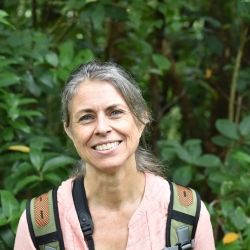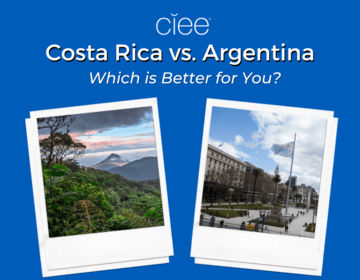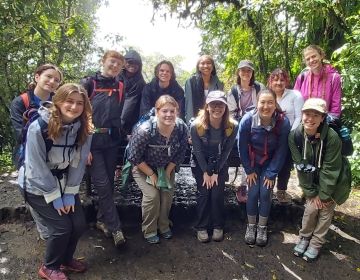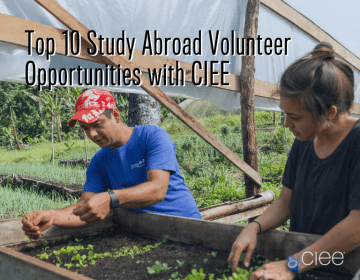INTERNSHIP IN THE CURATION OF WOMEN’S ART, HANDICRAFTS, AND HISTORY
Many of today’s working women of Monteverde labor in tourism, and a number of them earn their livelihoods as artisans and artists, often selling their work to tourists. For some women, their appreciation and understanding of the environment was first awakened when they began to produce handicrafts to sell, and a desire to protect biodiversity became a greater priority. Selling arts and handicrafts can help to empower women by opening up professional pathways, while also increasing environmental awareness by other sectors of society. This semester, two interns (Alex Chalmers and Yonah London, of Oberlin College), under the supervision of Ana Ovares, record the oral history of local women artists and then transform it into a visual exhibit for public display, discussion, and appreciation.
Alex and Yonah prepare the mounting boards. Yonah and Alex take stock of work completed, and work ahead.Alex Chalmers (Oberlin College)
This month I have been working on a project with local artist Ana Ovares and fellow CIEE student Yonah London, the goal of which is to celebrate the important contributions of female artisans to the Monteverde region. Through their art, these women raise awareness of the importance of the wildlife of the area, and in many cases directly protect the environment by turning trash into art. Many, though not all, of the 15 artists involved (this includes Ana) are members of CASEM Co-op in Monteverde. From them I learned of the strength of the artisan community, and the support it offers to its members. For many of the women this kind of work would have been impossible without this support. We heard stories of women who struggled for years with machisto husbands, fighting simply to make their art. So this is a project about not only supporting the environment, but support women in their struggle to receive equal treatment. I learned a lot throughout the process about the way art can be both a form of resistance and solidarity, with others in similar situations and with the environment. Additionally I was lucky enough to meet 15 incredibly inspiring women.
The project took place in several stages. First we interviewed the women, which involved walking or driving around the greater Monteverde area. We visited several different communities: Santa Helena, La Cruz, Cerro Plano, Cañitas, and finally took an hour long bus ride to La Guaria, near Guacimal. After the interviews we wrote up short biographies that tell a little about each woman’s background, the kinds of art they each work with, and some of their thoughts about art, gender, and the environment/environmental protection. The next phase was designing and constructing small boards for each woman, with the biographies, pictures, and an example of their art. These boards will be displayed outside the Banco Nacional for the next 6 months.
Alex positions art on the mounting board. Yonah contemplates the big picture...Yonah London (Oberlin College)
Throughout the month of March and the beginning of April I have been working on preparing a new exhibition to put on display outside of the Banco Nacional in the center of Santa Elena. The exhibit that we were working to create was one honoring the work of women artists and artisans in the community of Monteverde and replaced a poetry exhibition that formerly occupied the space outside of the bank. Our exhibit focuses on women’s art that incorporates nature or the use of recycled materials. During the four-week internship, I worked with another student, Alex Chalmers, and an advisor from the community, Ana Ovares, a local artist and holistic healer.
The first two weeks of the internship were spent traveling around the Monteverde area and interviewing women who work with art relating to the environment and using recycled materials. We conducted all of the interviews in Spanish, recorded them, and spent the late mornings and afternoons of the first two weeks writing up transcriptions of the interviews in the form of short biographies. When we interviewed the women, we also took pictures of them and of their work to use for the final exhibition. Most of the women also chose to give us a small piece of their artwork to display at the exhibition. During the second half of the internship, we started to put our display together. We first painted large pieces of wood that we received from a local woodworker: one for each woman, one for a map indicating where each lives, and one for a printed explanation of the project. In the last week of the internship we glued the pieces or art, photos, and biographies to each piece of wood and created the map and explanation of the project. By the end of the week we placed our completed exhibit outside the Banco Nacional.
Completed work! Yonah, Alex, Ana, and Drill
Related Posts
Costa Rica vs. Argentina: Which is Better for Study Abroad?
Imagine yourself sipping mate in a bustling Buenos Aires café or lounging peacefully in a hammock overlooking Costa Rica's lush rainforests. These contrasting scenes represent just a glimpse of the... keep reading
Happy Earth Day: Today and Every Day
Happy Earth Day! Every April 22, this global event comes around to remind us how precious our planet is, what sustainable efforts we can make to protect Earth, and that... keep reading
Top 10 Study Abroad Volunteer Opportunities with CIEE
Have you ever wondered if you could volunteer abroad? Perhaps you're looking into study abroad programs that provide international volunteer opportunities. If you’re itching to study abroad and truly make... keep reading



